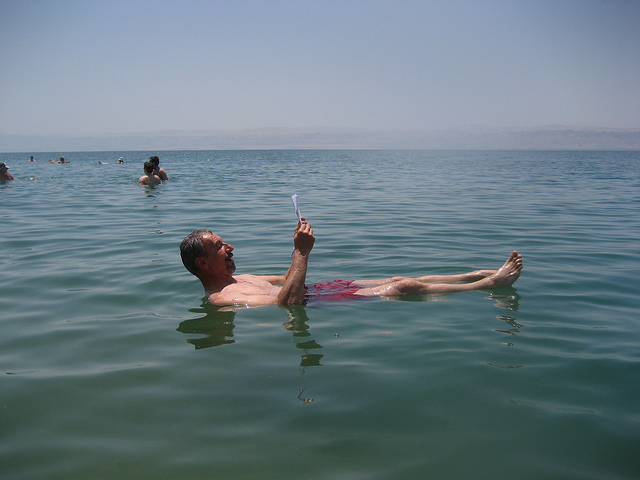Dead Sea rising: how the lowest place on Earth is getting (slightly) higher
Declining water levels are causing the floor of the Dead Sea to rise, according to a new study.
With less water to weigh it down, the sea’s bed is now rising at a rate of about 5 mm (0.2 in) per year, said Ran Nof, a PhD candidate at Israel’s Ben-Gurion University of the Negev, and lead author on the study to be published May 25 in the Journal of Geophysical Research-Solid Earth, a journal of the American Geophysical Union.
The sea, located between Israel and Jordan, is primarily fed by the Jordan River. In the past few decades both Jordan and Israel have increased the amount of water taken from the river, leading to lower flows reaching the Dead Sea, Nof said. Jordanian and Israeli mineral industries also pump large quantities of water directly from the sea into evaporation ponds to harvest minerals like magnesium and various salts, he said.
The Dead Sea doesn’t get much help from rainfall, either – the region gets about 50 mm (2 in) of rain per year. The arid climate, combined with water withdrawals for agriculture and industry, has led the water level to drop about 27 meters (89 feet) since 1960, to its current level of 422 meters (1,385 feet) below sea level, Nof said. Less water in the sea means less weight pressing the sea floor down. This causes uplift of the sea bed.
Even waterless, the Dead Sea would not be at risk of losing its standing as the lowest place on Earth, said Nof. The second lowest place is the Sea of Galilee in Israel, with a sea floor elevation of 211 m (693 ft) below sea level. The lowest point of the Dead Sea’s sea bed, located in its northern basin, is 700 m (2,297 ft) below sea level.
A seabed uplift of several millimeters, as found in the current study, might seem small. But Nof said it could affect the amount of stress on active earthquake faults in the area – although whether that would trigger or quiet earthquakes hasn’t been studied for the Dead Sea region.
The newly measured uplift could be temporary. Jordan and Israel are taking steps to curb the declining water levels with the Red Sea-Dead Sea Canal, which would bring water from the Red Sea to the Dead Sea. This project could restore the Dead Sea’s water level, adding water weight that would cause subsidence and return the sea’s bed to its original height, Nof said.
With less water to weigh it down, the sea’s bed is now rising at a rate of about 5 mm (0.2 in) per year, said Ran Nof, a PhD candidate at Israel’s Ben-Gurion University of the Negev, and lead author on the study to be published May 25 in the Journal of Geophysical Research-Solid Earth, a journal of the American Geophysical Union.
The sea, located between Israel and Jordan, is primarily fed by the Jordan River. In the past few decades both Jordan and Israel have increased the amount of water taken from the river, leading to lower flows reaching the Dead Sea, Nof said. Jordanian and Israeli mineral industries also pump large quantities of water directly from the sea into evaporation ponds to harvest minerals like magnesium and various salts, he said.
The Dead Sea doesn’t get much help from rainfall, either – the region gets about 50 mm (2 in) of rain per year. The arid climate, combined with water withdrawals for agriculture and industry, has led the water level to drop about 27 meters (89 feet) since 1960, to its current level of 422 meters (1,385 feet) below sea level, Nof said. Less water in the sea means less weight pressing the sea floor down. This causes uplift of the sea bed.
Even waterless, the Dead Sea would not be at risk of losing its standing as the lowest place on Earth, said Nof. The second lowest place is the Sea of Galilee in Israel, with a sea floor elevation of 211 m (693 ft) below sea level. The lowest point of the Dead Sea’s sea bed, located in its northern basin, is 700 m (2,297 ft) below sea level.
A seabed uplift of several millimeters, as found in the current study, might seem small. But Nof said it could affect the amount of stress on active earthquake faults in the area – although whether that would trigger or quiet earthquakes hasn’t been studied for the Dead Sea region.
The newly measured uplift could be temporary. Jordan and Israel are taking steps to curb the declining water levels with the Red Sea-Dead Sea Canal, which would bring water from the Red Sea to the Dead Sea. This project could restore the Dead Sea’s water level, adding water weight that would cause subsidence and return the sea’s bed to its original height, Nof said.
Nof, R., Ziv, A., Doin, M., Baer, G., Fialko, Y., Wdowinski, S., Eyal, Y., & Bock, Y. (2012). Rising of the lowest place on Earth due to Dead Sea water-level drop: Evidence from SAR interferometry and GPS Journal of Geophysical Research, 117 (B5) DOI: 10.1029/2011JB008961
Eric Villard, AGU science writing intern | http://blogs.agu.org


Comentários
Postar um comentário